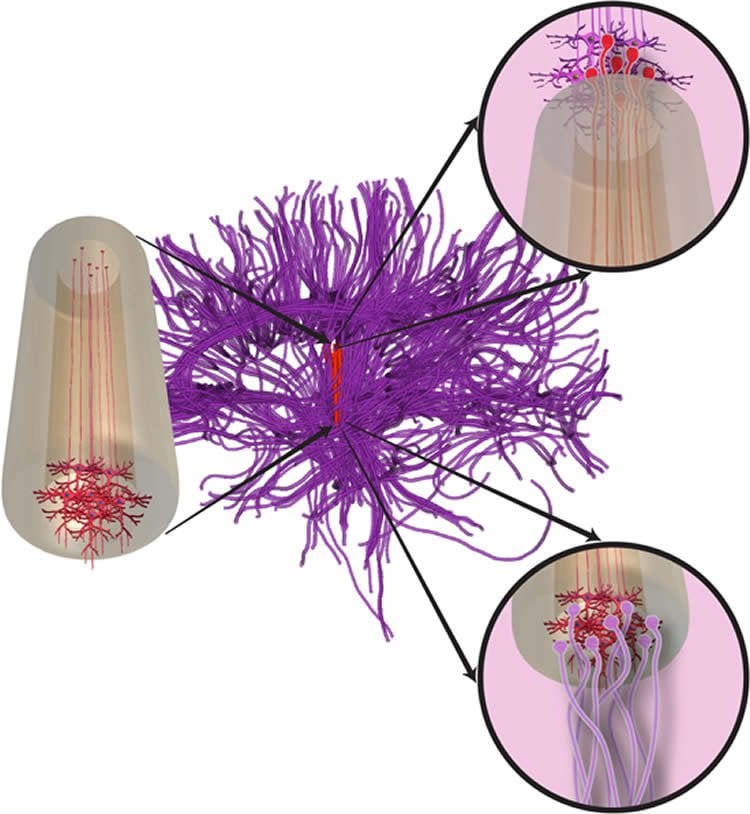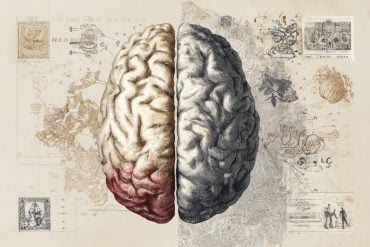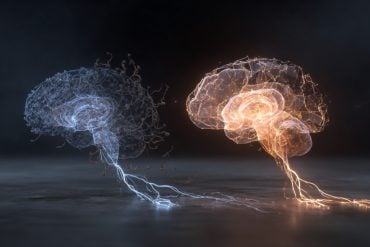Lab-grown neural networks have the ability to replace lost axonal tracks in the brains of patients with severe head injuries, strokes or neurodegenerative diseases and can be safely delivered with minimal disruption to brain tissue, according to new research from Penn Medicine’s department of Neurosurgical Research. Their work is published in the Journal of Neural Engineering.
Complex brain function derives from the activity of populations of neurons – discrete processing centers – connected by long fibrous projections known as axons. When these connections are damaged, by injury or diseases such as a Parkinson’s or Alzheimer’s disease, they, unlike many other cells in the body, have very limited capacity to regenerate, thus permanently disrupting the body’s signal transmission and communication structure.
Senior author D. Kacy Cullen, PhD, an assistant professor of Neurosurgery and his team have been working to grow replacement connections, referred to as micro-tissue engineered neural networks (micro-TENNS), in the lab and test their ability to “wire-in” to replace broken axon pathways when implanted in the brain. Cullen’s team advanced the micro-TENNs to consist of discrete populations of mature cerebral cortical neurons spanned by long axonal projections within miniature hair-like structures. These micro-TENNs are the first transplantable neural networks that mimic the structure of brain pathways in a miniature form.
In a previous 2015 publication in Tissue Engineering, Cullen and colleagues showed that preformed micro- TENNS could be delivered into the brains of rats to form new brain architecture that simultaneously replaced neurons as well as long axonal projections. “The micro-TENNS formed synaptic connections to existing neural networks in the cerebral cortex and the thalamus – involved in sensory and motor processing – and maintained their axonal architecture for several weeks to structurally emulate long-distance axon connections,” Cullen reported. This work was the first to demonstrate that living micro-TENNS could successfully integrate into existing brain structures and reconstitute missing brain pathways, but, the team observed the need for improvement in how they were delivered to the brain, as this initial study required that the micro-TENNs be drawn into needles.
In response, the research team developed a new, less invasive delivery method by applying an ultra-thin coating to the micro-TENNs using a gel commonly found in food and biomedical products. This new biomaterial strategy allows the encapsulation of fully formed engineered neural networks for insertion into the brain without the use of a needle. “We searched for materials that could form a hard shell that would soften immediately following insertion to better match the mechanical properties of the native brain tissue,” Cullen said. This, the team hypothesized, would minimize the body’s reaction and improve the survival and integration of the neural networks. The additional coating was not detrimental to the number of surviving neurons, and the needleless method substantially reduces the implant footprint, suggesting that it would cause less damage and thus provide a more hospitable environment for implanted neurons to integrate with the brain’s existing nervous system. “Additional research is required to directly test micro-TENN neuron survival and integration for each of these insertion methods,” Cullen said.

Cullen and team plan to perfect their processes and further integrate neuroscience and engineering to come up with unique ways to aid patients suffering from brain injury or common neurodegenerative diseases such as Parkinson’s and Alzheimer’s disease.
“We hope this regenerative medicine strategy will someday enable us to grow individualized neural networks that are tailored for each patient’s specific need,” he said, “ultimately to replace lost neural circuits and improve brain function.”
Funding: Funding for this study was provided by the National Science Foundation (Graduate Research Fellowship DGE-1321851), NIH (T32-NS043126 and T32-GM007517), and the Department of Veterans Affairs (RR&D Merit Review #B1097-I). The University of Pennsylvania has intellectual property covering this technology, and Dr. Cullen is an inventor.
Source: Lee-Ann Donegan – University of Pennsylvania
Image Source: The image is credited to Cullen et al./Journal of Neural Engineering
Original Research: Full open access research for “Advanced biomaterial strategies to transplant preformed micro-tissue engineered neural networks into the brain” by J P Harris, L A Struzyna, P L Murphy, D O Adewole, E Kuo1, and D K Cullen in Journal of Neural Engineering. Published online January 13 2016 doi:10.1088/1741-2560/13/1/016019
Abstract
Advanced biomaterial strategies to transplant preformed micro-tissue engineered neural networks into the brain
Objective. Connectome disruption is a hallmark of many neurological diseases and trauma with no current strategies to restore lost long-distance axonal pathways in the brain. We are creating transplantable micro-tissue engineered neural networks (micro-TENNs), which are preformed constructs consisting of embedded neurons and long axonal tracts to integrate with the nervous system to physically reconstitute lost axonal pathways.
Approach. We advanced micro-tissue engineering techniques to generate micro-TENNs consisting of discrete populations of mature primary cerebral cortical neurons spanned by long axonal fascicles encased in miniature hydrogel micro-columns. Further, we improved the biomaterial encasement scheme by adding a thin layer of low viscosity carboxymethylcellulose (CMC) to enable needle-less insertion and rapid softening for mechanical similarity with brain tissue.
Main results. The engineered architecture of cortical micro-TENNs facilitated robust neuronal viability and axonal cytoarchitecture to at least 22 days in vitro. Micro-TENNs displayed discrete neuronal populations spanned by long axonal fasciculation throughout the core, thus mimicking the general systems-level anatomy of gray matter—white matter in the brain. Additionally, micro-columns with thin CMC-coating upon mild dehydration were able to withstand a force of 893 ± 457 mN before buckling, whereas a solid agarose cylinder of similar dimensions was predicted to withstand less than 150 μN of force. This thin CMC coating increased the stiffness by three orders of magnitude, enabling needle-less insertion into brain while significantly reducing the footprint of previous needle-based delivery methods to minimize insertion trauma.
Significance. Our novel micro-TENNs are the first strategy designed for minimally invasive implantation to facilitate nervous system repair by simultaneously providing neuronal replacement and physical reconstruction of long-distance axon pathways in the brain. The micro-TENN approach may offer the ability to treat several disorders that disrupt the connectome, including Parkinson’s disease, traumatic brain injury, stroke, and brain tumor excision.
“Advanced biomaterial strategies to transplant preformed micro-tissue engineered neural networks into the brain” by J P Harris, L A Struzyna, P L Murphy, D O Adewole, E Kuo1, and D K Cullen in Journal of Neural Engineering. Published online January 13 2016 doi:10.1088/1741-2560/13/1/016019






